Intel Core i7-3960X Review: Sandy Bridge-E And X79 Express
Intel's Sandy Bridge design impressed us nearly a year ago, but it was intended for mainstream customers. The company took its time readying the enthusiast version, Sandy Bridge-E. Now, the LGA 2011-based platform and its accompanying CPUs are ready.
Say Hello To The PC Hardware Trophy Wife
According to Mick Jagger, it’s lonely at the top. Intel might agree. After all, for the past five years, the company has put an increasingly large gap between its fastest desktop processors and AMD’s own best efforts. Enthusiasts tend to lament the fact that a lack of intense competition means they pay more for high-end hardware. But, if you’ve been around long enough, you know that Intel’s Extreme Edition CPUs were always thousand-dollar affairs and, once upon a time, AMD’s vaunted FX-series chips used to be worth their $700+ asking prices.
The fact that the $1000 price point persists today, eight years later, means Intel recognizes the extremely limited market for these flagship desktop processors and isn’t about to push one of its crown jewels even further out of reach.
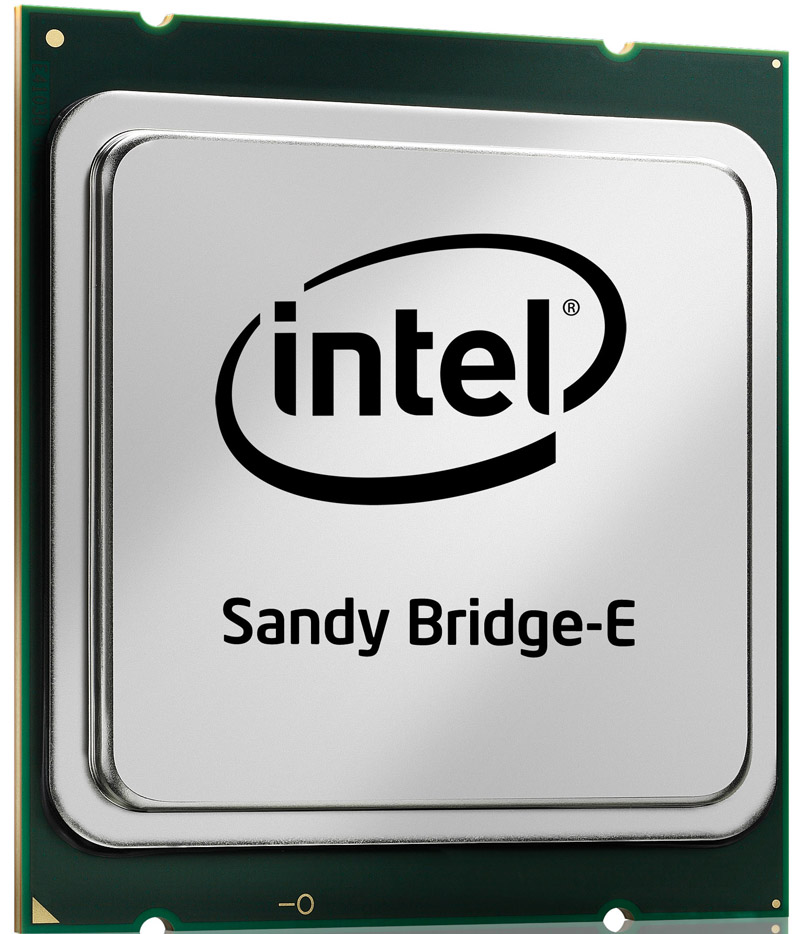
It comes as little surprise, then, to see yet another Extreme Edition processor hovering around $1000. But this behemoth is very different than what came before.
The prior generation of flagship parts based on Gulftown came armed with six physical cores and up to 12 MB of shared L3 cache. They boasted LGA 1366 compatibility, extending the useful lives of pricey X58 Express motherboards, helping soften the blow of $500+ processor upgrades. No such luck this time; you’re facing a pricier investment.
Sandy Bridge-E, Gulftown’s successor, employs an LGA 2011 interface, requiring new motherboards based on Intel’s X79 Express Platform Controller Hub. It also comes armed with an integrated quad-channel memory controller, necessitating four-module memory kits. Oh, and then there’s the fact that Intel isn’t planning to bundle its new chips with coolers, requiring a separate purchase there, too.
Meet Sandy Bridge-E
Intel is announcing three Sandy Bridge-E-based models today, but only two will be available through the end of 2011: Core i7-3960X and Core i7-3930K. The third, Core i7-3820, is slated for a Q1 2012 introduction.
Stay On the Cutting Edge: Get the Tom's Hardware Newsletter
Get Tom's Hardware's best news and in-depth reviews, straight to your inbox.
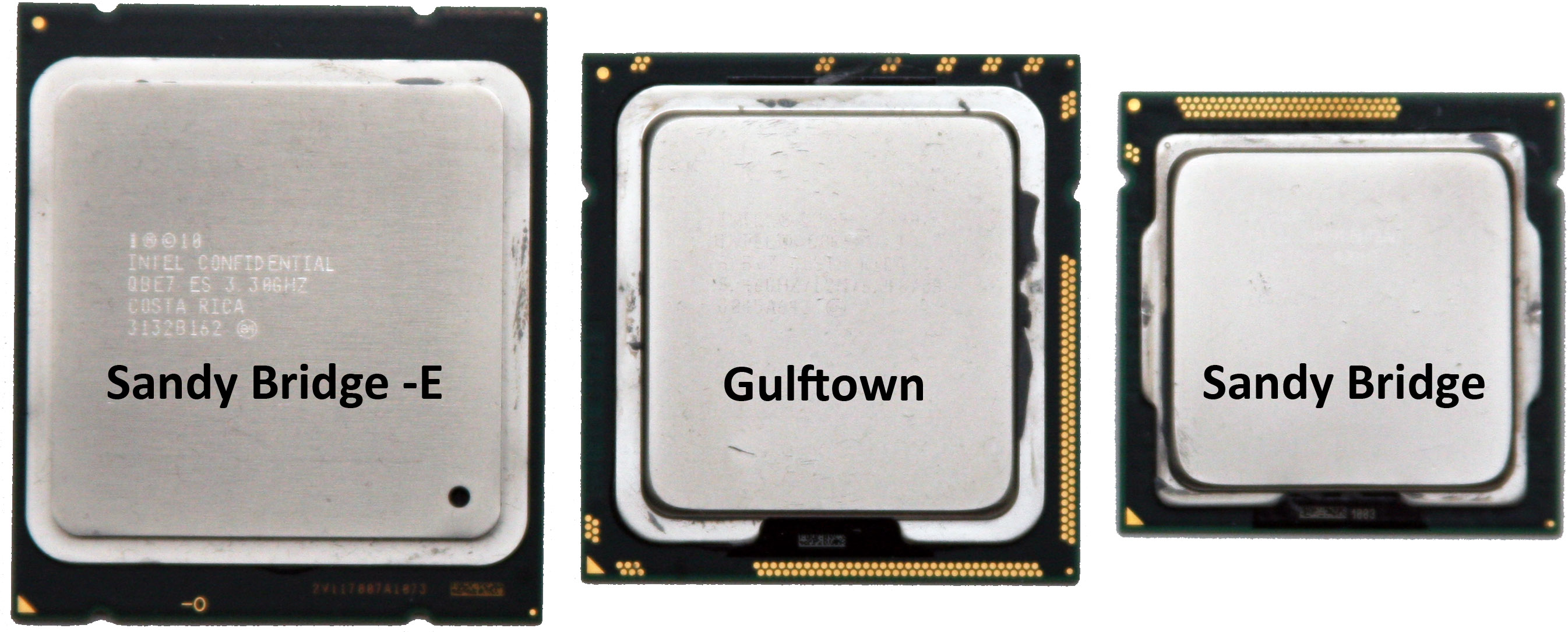
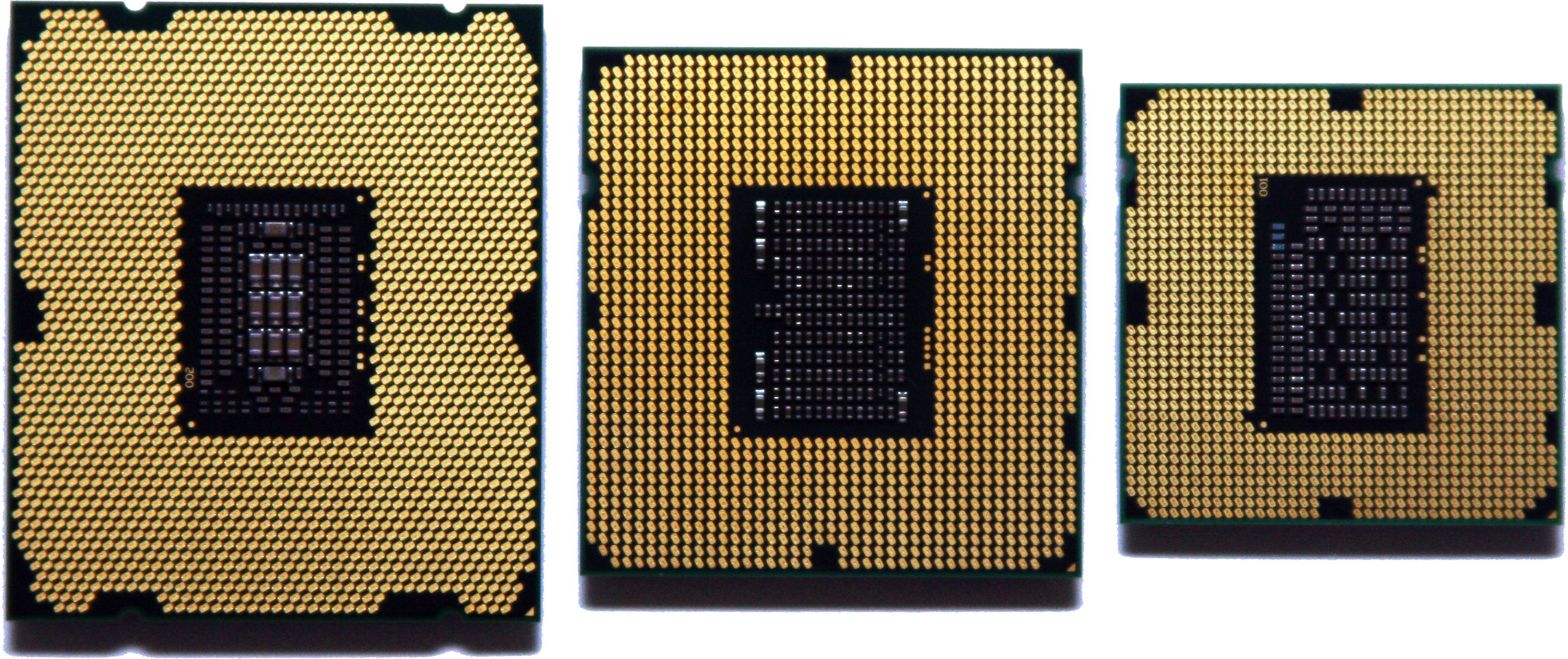
All three employ the same die, which is composed of 2.27 billion transistors and measures 434 square millimeters (making it a very big chip). In comparison, quad-core Sandy Bridge parts are made up of 995 million transistors and measure 216 square millimeters, while six-core Gulftown CPUs incorporate more than 1.1 billion transistors in a 248 square millimeter die.
Of course, Sandy Bridge-E was never intended to be a desktop processor exclusively. Rather, it’s going to emerge in the first part of next year as Xeon E5 for single- and dual-socket servers/workstations. In that context, the CPU’s size and complexity makes more sense. After all, Westmere-EX (at the heart of Intel’s more enterprise-oriented Xeon E7 family) is a 2.6 billion-transistor die occupying 513 square millimeters of space.
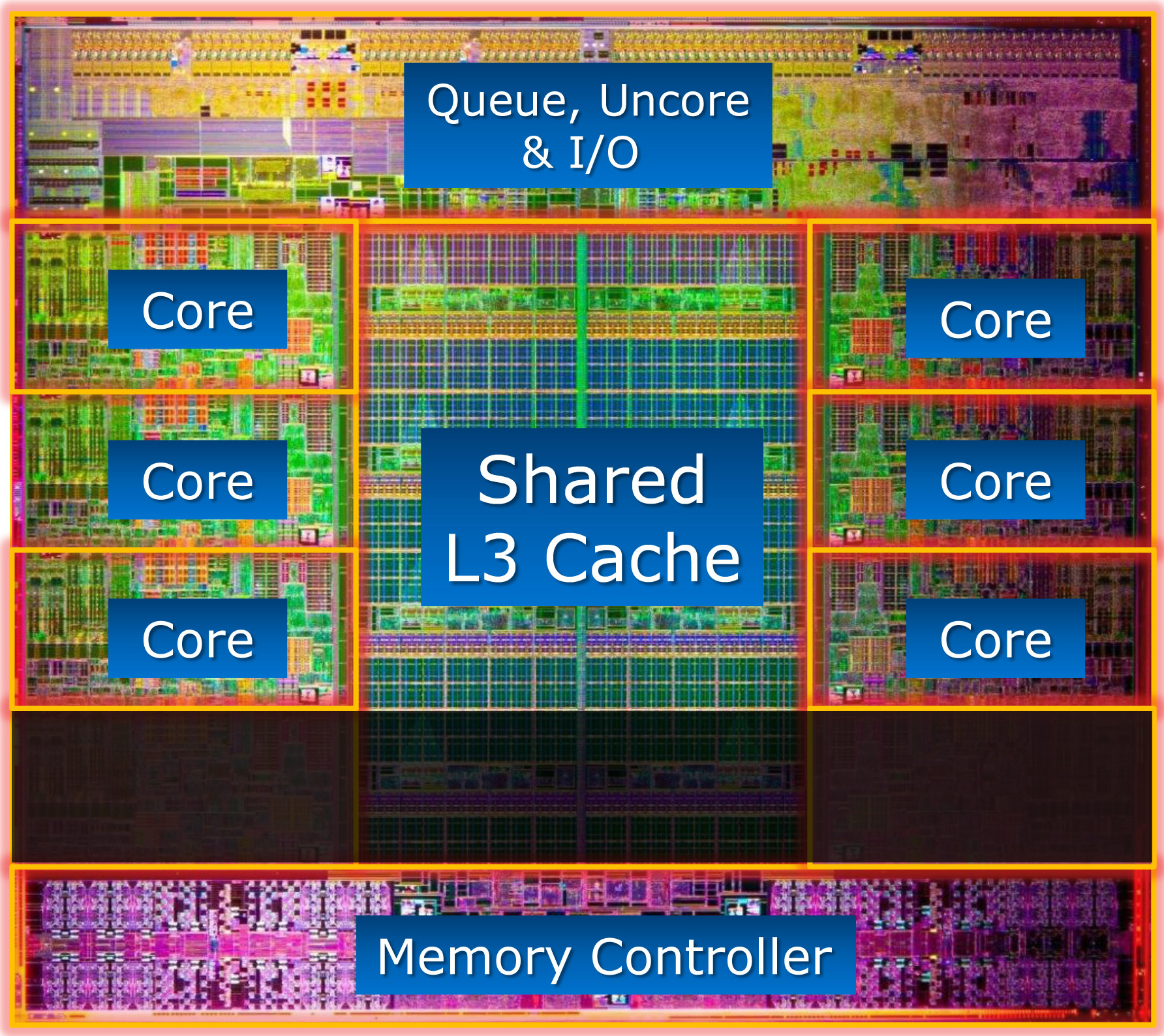
When Sandy Bridge-E surfaces as Xeon, it’ll offer up to eight processing cores and 20 MB of shared L3 cache. As a desktop CPU, however, it’s limited to as many as six cores and up to 15 MB of shared L3. Intel achieves this by disabling two cores and four of the die’s 16 slices of shared L3 cache.
Of course, that configuration only applies to Core i7-3960X. Core i7-3930K, which also features six cores, dips down to 12 MB of cache, revealing Intel’s ability to very granularly disable pieces of the shared L3 to suit its needs. The upcoming Core i7-3820 will employ four cores and 10 MB of shared L3 cache—essentially half of a Sandy Bridge-E die. Each core includes 32 KB of L1 instruction and L1 data cache, plus a dedicated 256 KB L2 cache.
| Sandy Bridge-E Family | |||||||
|---|---|---|---|---|---|---|---|
| Row 0 - Cell 0 | Base Clock | Max. Turbo | Cores / Threads | L3 Cache | TDP | Memory | Price |
| Core i7-3960X | 3.3 GHz | 3.9 GHz | 6 /12 | 15 MB | 130 W | 4-Channel DDR3-1600 | $990 |
| Core i7-3930K | 3.2 GHz | 3.8 GHz | 6 / 12 | 12 MB | 130 W | 4-Channel DDR3-1600 | $555 |
| Core i7-3820 | 3.6 GHz | 3.9 GHz | 4 / 8 | 10 MB | 130 W | 4-Channel DDR3-1600 | TBD |
The clocks on all three SKUs range up and down as well. The -3960X starts at 3.3 GHz and, through the same second-gen Turbo Boost technology introduced with Sandy Bridge, speeds up to 3.9 GHz. The -3930K starts at 3.2 GHz and hits a peak of 3.8 GHz in lightly-threaded workloads. Finally, the -3820 will start at 3.6 GHz and reach frequencies of up to 3.9 GHz with Turbo Boost.
Of course, the X- and K-series chips are also multiplier-unlocked, making those stock clocks pretty much meaningless for most enthusiasts planning to tweak their systems. Intel calls the -3820 “partially unlocked.” In all actuality, it gets six 100 MHz bins above its maximum Turbo Boost setting of 3.9 GHz, translating to a ceiling of 45x.
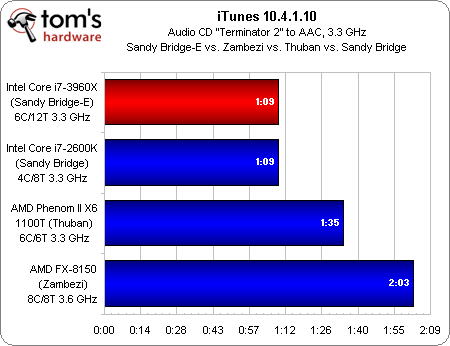
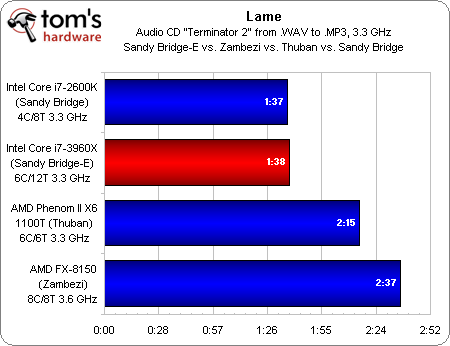
Intel is using the same cores found in its Sandy Bridge-based CPUs. Turning off Turbo Boost, setting similar base clocks, and running a couple of single-threaded apps demonstrates the efficient execution Sandy Bridge brings to the table compared to Thuban or Zambezi.
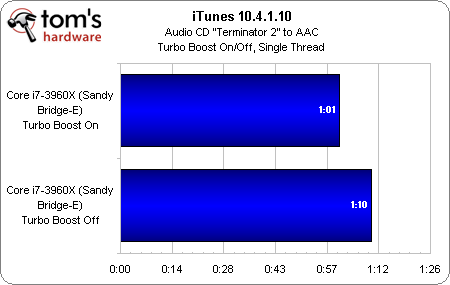
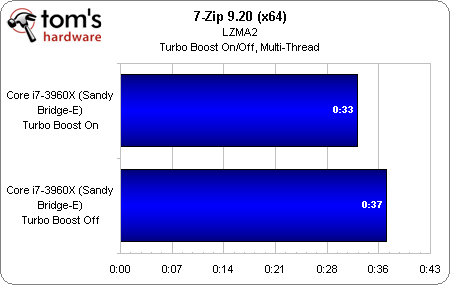
Switching Turbo Boost back on and running Core i7-3960X in parallelized and single-threaded titles gives us a better impression of what that technology does for performance.
In an application like iTunes, which is only able to utilize one core, Turbo Boost improves performance by 12.8%. In 7-Zip (well-optimized to use available cores), it increases performance by 10.8%. The second number is surprisingly high because Turbo pushes an additional three 100 MHz bins when five or six cores are active and none of the technology’s triggers are tripped. As a result, it's tackling our compression workload at 3.6 GHz instead of 3.3.
Current page: Say Hello To The PC Hardware Trophy Wife
Next Page Quad-Channel Memory And PCI Express 3.0-
SpadeM So no SAS/Full Sata 3 ports but u do get PCIe 3 ... no Quicksync but u do get 2 more cores and the added cache ... no USB 3.0 but u get quad channel memory which in real life every day computing is a minimal gain at best. Feels an awful lot like a weak trade if you ask me. I'm basically asked to buy the P67 chipset with sprinkles on top. And for 1000$ it feels like it falls short. For heavy workloads it's cheaper and faster to make yourself 2 systems based on 1155 or bulldozer and render, fold, chew numbers that way. X79 should have launched with an ivy bridge based cpu inside and a better chipset to live to it's name.Reply
What we have today is simply a platform for bragging rights not a serious contender to the X38, X48, X58 family. -
illfindu Not to take the review to much off topic but its worth bringing up because this review was so complete , as in covering a vast array of situations and programs. Its truly embarrassing for AMD that the FX-8XXX series is beaten not only bye chips with half the cores but half the cores that are a generation behind. In fact as of this moment the FX set is almost inspiring it its lack of any value at first glance at some of these marks one could say that AMD's most expensive chip at over 200$ is one of its slowest being beaten bye both the x4 and x6 phenoms.Reply -
redsunrises Illfindu, you are beating a dead horse... Old news, lets move on (sorry, just tired of the same thing being said over and over, which will end in an amd fanboy fight). Great review though!Reply -
ohim This article tells me 2 things , either our current software is a total piece of crap since it has absolutely no clue of multi core cpus, or the future without AMD is so grim that intel makes you pay 1000 bucks for a cpu that doesn`t perform really that fast ... but for sure the software industry needs to take a better look at those multicore optimisations.Reply -
stonedatheist I think Intel would be raking in the dough if they left all 8 cores enabled for the 3960X. I doubt that a later revision will enable them. 8c/16t will probably hit the desktop with IB-E (can't wait) :)Reply -
joytech22 :| Well AMD is fighting a losing battle.. (In High-End CPU's, which I actually use for rendering etc..)Reply
I would LOVE to see them pick up their game and provide me with a worthy upgrade over my 4GHz i7 2600 (Non-K). I would swoop it up.
Look, BD had 4 modules with two "cores" each, each module is equivalent to a Sandy Bridge core.
They should just combine both of those cores or make them a single core, so we get 4 threads.
Then create 4-6-8 core versions of those CPU's..
Think about it.. the FX8150 is more of a 4-core CPU where the resources are halved pretty much so you get two threads per core, it would have been MUCH MUCH better if they just kept 4 strong cores.
Not sure why either but I always seem to start an AMD related comment :\ -
JeanLuc Hi Chris,Reply
The labels are wrong on the graphs on this page the last ones should read DDR2-2133 on the last two shouldn't it?
JeanLuc
